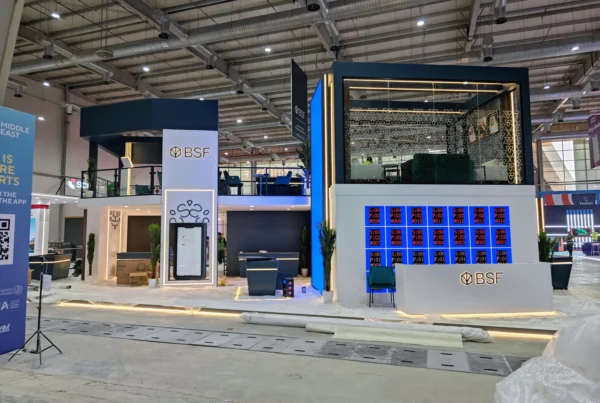The digital interactive experience has come a long way from simple on-screen animations and conventional virtual tools. By 2025, artificial intelligence (AI) is poised to take these interactions to unprecedented heights—across live events, retail, and virtual showrooms—reshaping how brands engage with consumers, how attendees explore immersive experiences, and how real estate developers showcase properties. As technological breakthroughs converge, AI stands at the forefront of delivering personalized, real-time, and data-rich content that resonates deeply with users, no matter the industry context.
In this comprehensive overview, we’ll explore the past, present, and future of AI’s role in shaping the digital interactive experience, focusing on how these advancements yield adaptive, people-centric interactions for large-scale events, next-generation retail, and immersive real estate applications. We’ll also highlight essential best practices, data considerations, and real-world examples, guiding you toward harnessing AI’s power without overwhelming your budget or infrastructure.
1. The Rapid Evolution of AI and Its Role in Interactive Experiences
1.1 A Brief History of AI’s Growth
Artificial intelligence has progressed from rule-based logic systems to sophisticated machine learning and deep learning frameworks capable of natural language understanding, computer vision, and real-time decision-making. Milestones like the widespread adoption of neural networks in the 2010s and the rise of generative models in the 2020s paved the way for AI to permeate event production, retail strategies, and real estate marketing.
AI’s mainstream impact is evident in recent retail reports—AI-Influenced Shopping Boosts Online Holiday Sales, Salesforce Data Shows. This piece indicates a 4% increase in U.S. online holiday sales, driven by a staggering 42% rise in chatbot interactions. Similarly, How AI Fueled Black Friday Shopping This Year points to a 10.2% online sales boost and an 1,800% surge in traffic from AI chatbots. Together, these findings underline how swiftly AI-based personalization can augment user journeys.
1.2 AI Meets the Digital Interactive Experience
Simultaneously, the demand for richer experiences has grown. As explained in Immersive Interactive Technology for Events: The Key to Memorable Brand Experiences, event attendees and online users want more than static pages and formulaic presentations. AI complements immersive tools like augmented reality (AR), virtual reality (VR), or even digital twin simulations by adapting content to user preferences, location data, or emotional states in real time, ensuring that each interaction feels unique and high-impact.
2. AI in 2025: Key Technologies Enabling Adaptive Interactions
2.1 Advanced Machine Learning & Personalization
By 2025, deep learning models have evolved to become leaner, faster, and more capable of analyzing user signals on the fly. This progress fosters a digital interactive experience that is fluid, reacting to each user’s immediate context—whether at a trade show kiosk or an e-commerce store. Chatbots leverage advanced NLP to deliver near-human conversation, tailoring product suggestions or event session recommendations to individual interests.
How American Express, DoorDash, JP Morgan Chase, and More Are Using AI to Improve Business illustrates the breadth of AI’s infiltration into marketing, personalization, and analytics, highlighting universal tactics that apply to both physical events and online platforms.
2.2 Computer Vision & Gesture Recognition
Thanks to breakthroughs in GPUs and AI frameworks, cameras and sensors can now detect subtle facial expressions, track body movements, and parse large crowds at real-time speeds. For instance, an event booth might change LED lighting or promotional content based on the cumulative sentiment of visitors. A retail pop-up might deliver product details when it “sees” a shopper pause at a display, turning a standard kiosk into an interactive brand ambassador.
2.3 AI-Driven Robotics & Public-Facing Autonomy
Physical robots and drones are also stepping out of manufacturing lines into user-facing roles, as discussed in AI Robots Are Entering the Public World—With Mixed Results. By 2025, we can expect more robots in retail showrooms, trade fairs, or event registration areas, greeting attendees, offering guided tours, or collecting real-time feedback. Venture-capital investment in robotics soared to $12.8 billion in 2024, suggesting strong momentum for these automated machines that enhance the digital interactive experience in physical spaces.
2.4 Metaverse-Like Platforms & Persistent Worlds
AI is fueling the development of persistent 3D worlds—often described as the metaverse—where attendees and shoppers can engage with each other and with dynamic, data-driven content. Companies are reevaluating how they offer brand experiences, from large conferences with VR networking lounges to real estate showrooms that exist 24/7, powered by AI to keep content fresh and adaptive.
3. Transforming Events: AI-Powered Personalization & Immersion
3.1 Pre-Event Intelligence & Curated Agendas
At major conferences or expos, AI can parse through attendee profiles to suggest sessions, exhibitors, or even networking matches that align with each person’s goals. Event planners then harness these data-driven suggestions to create individualized schedules. This approach ensures visitors don’t waste time searching for relevant sessions, thereby boosting satisfaction and cutting confusion.
Leaders from BCG, Infosys, AARP, and More Predict How AI Will Transform Top Companies in the Next 12 Months details how organizations deploy AI to streamline employee tasks—parallel logic applies to event workflows, automating routine tasks like check-ins, itinerary planning, and real-time personalization.
3.2 Dynamic On-Site Environments
During the event, AI can handle everything from crowd flow to session scheduling. For instance, if a keynote runs longer than expected or an unexpected spike in attendee interest arises, AI engines automatically rearrange session times or recommend alternative spaces. Real-time digital interactive experience solutions pop up to guide attendees via AR navigation or interactive signage. A prime example of large-scale signage technology is the Smart Digital Signage Revolution for T-Mobile, illustrating how data-driven content management streamlines user engagement across multiple store locations—logic that easily translates into event floor navigation or promotional displays.
3.3 Multi-User VR, AR & Metaverse Interactions
AR-based product demos and VR brand showrooms are already common in event experiences. By 2025, AI will add a personalization layer—for instance, an AR station recognizing an attendee’s preference for eco-friendly solutions and highlighting relevant features. Or VR experiences updating in real time based on the user’s emotional cues, gleaned from wearable sensors or camera-based expression analysis, making the event more immersive and memorable.
Future Trends: UE5.5, GeForce GTX 5000, and the Next Wave of Digital Twin for Real Estate and Events suggests how upgraded hardware and engines like Unreal Engine 5.5 will handle advanced AI solutions with minimal latency, ensuring stable, high-fidelity experiences for large groups.

4. AI in Retail & Virtual Showrooms: The Next Generation of the Digital Interactive Experience
4.1 Personalized Shopping Journeys
Retailers already see the impact of AI in driving sales. Over the 2024 holiday season, AI-Influenced Shopping Boosts Online Holiday Sales, Salesforce Data Shows pointed to a 42% jump in chatbot interactions fueling a 4% sales increase. Meanwhile, How AI Fueled Black Friday Shopping This Year reported a 10.2% rise in online sales, with an 1,800% surge in traffic from AI chatbots. By 2025, advanced recommendation algorithms in physical and online stores will adapt product displays or marketing campaigns in real time, offering a digital interactive experience that merges e-commerce personalization with tangible brand engagement.
4.2 Virtual & Hybrid Showrooms
Thanks to real-time 3D modeling and digital twin platforms, entire showrooms can exist virtually. AI bots could serve as virtual sales associates, analyzing shopper behavior to present tailored product combos or upsells. Real estate developers already employ digital twins to display off-plan properties—The Rise of Digital Twin in Real Estate: From Concept to Industry Standard explains how advanced visualization merges with AI-driven occupant modeling to produce a compelling interactive journey. By 2025, these experiences will be even more nuanced, with AI Metahumans greeting prospective clients, guiding them through property features, and dynamically adapting to user questions or preferences.
4.3 Intelligent Inventory & Supply Chain Management
Behind the scenes, AI can optimize stock levels, shipping timetables, and resource deployment based on real-time demands—an approach used by major players like American Express and JPMorgan to streamline operations, as featured in How American Express, DoorDash, JP Morgan Chase, and More Are Using AI to Improve Business. This synergy between front-end customer experience and back-end data orchestration forms a unified digital interactive experience that seamlessly aligns marketing with supply readiness.
5. Data Privacy, Security, and Ethical Considerations
5.1 Handling Sensitive Data
Whether analyzing event attendee behavior or providing personalized retail suggestions, AI relies heavily on data. This could include location tracking, facial expressions, or even heart rate information from wearables. Storing and processing such data ethically is non-negotiable, especially under evolving regulations like GDPR or U.S. state-specific privacy laws.
5.2 Transparent AI Usage
Modern users are wary of “black box” AI systems collecting data without disclosure. Clear disclaimers—what data is being collected, how it’s used, and how it can be opted out of—build trust and ensure compliance. Virtual guides at trade shows or AI chatbots in digital twin showrooms should clarify their AI nature.
5.3 Bias & Fairness
AI models risk unintentional discrimination if trained on skewed datasets. For instance, in a global retail event, personalization could fail to account for cultural diversity or language nuances. Similarly, real estate marketing might inadvertently target certain demographics over others. Regular audits, inclusive training data, and governance structures are crucial.
5.4 Technical Safeguards
Encryption, secure log management, and fail-safes (in case AI decision logic falters) are essential. Implementing robust cybersecurity is especially critical in high-stakes environments like large-scale conferences or major brand launches, where data breaches could be catastrophic for brand reputation.
6. Technical & Operational Challenges
6.1 Skills Gap
Deploying AI across events, retail, or real estate demands expertise—data scientists, 3D artists, and system integrators well-versed in real-time engines such as Unreal Engine or Unity. Smaller organizations might struggle to find or afford this specialized talent, so partnerships or outsourcing become vital.
6.2 Infrastructure Requirements
High concurrency events or large-scale interactive showrooms need robust server architecture and network capacity. Low-latency 5G or edge computing solutions can help meet these demands, but setting them up may be expensive or complex.
6.3 ROI & Cost Management
Determining how AI-driven experiences directly influence brand awareness, conversions, or sales can be tricky. Adopting a phased approach—testing smaller pilot features first—allows companies to gather data on effectiveness, refine their approach, and build a case for larger investments. For budget insights, see Planning Your Budget: How to Invest Wisely in Immersive Event Technology Solutions.
7. Looking Ahead: AI and the Future of the Digital Interactive Experience
7.1 AI-Driven Metaverse Environments
As metaverse platforms evolve, AI could become the linchpin that keeps virtual worlds fresh and reactive. For instance, an AI-based event platform can spontaneously craft brand new content or shift virtual environments based on group sentiment, delivering a continuous, personalized dimension to the digital interactive experience.
7.2 Next-Gen Hardware Accelerations
Emerging GPU innovations and neural processing units (NPUs) offer real-time, on-device AI processing, diminishing the need for massive cloud backends. This fosters distributed networks of interactive displays, drones, or robots collaborating at events or retail spaces without significant latency.
7.3 Continuous Learning Systems
Future AI models may accumulate knowledge from multiple events or store visits, refining interactions with each new data point. This living intelligence extends beyond single usage scenarios—imagine an AI guide that “remembers” frequent visitors at a store or event series, greeting them with personalized updates.
8. Case Studies & Use Cases
8.1 Real Estate: AI + Digital Twin
Consider a large development project like the Riyadh Digital Twin: A New Dimension in Urban Visualization. By adding AI that interprets occupant behavior or buyer preferences, the digital twin can automatically present tailored apartment configurations or neighborhood details, streamlining off-plan sales and cutting site visits.
8.2 Event Experience: AI-Guided Attendees
At a major trade show, AI chatbots could analyze attendee profiles, direct them to relevant booths, and even suggest topics or sessions they might not realize they’re interested in. AR or VR setups become more engaging, adjusting content dynamically as user feedback or interest peaks. Event branding extends to all corners, with AI-driven lighting and audio responding to audience energy levels.
8.3 Retail: Hyper-Personalized Shopping Journeys
Building on the success metrics described in How AI Fueled Black Friday Shopping This Year—including a 10.2% sales increase and an 1,800% chatbot-driven traffic jump—imagine a physical store merging AI-driven analytics with interactive product stands. Cameras identify shopper stress or excitement, updating product recommendations accordingly. Meanwhile, advanced digital signage systems let customers compare items or see AR overlays for sizing and styling tips.
With continued hardware improvements and design best practices gleaned from real-time engines, the entire user journey from store entry to checkout is orchestrated by AI to provide a more thoughtful, frictionless experience—ultimately fueling brand loyalty and revenue growth.
9. Conclusion & Actionable Steps
The march of AI into 2025 is reshaping the digital interactive experience, from personalizing large-scale events to revolutionizing retail showrooms and real estate marketing. By leveraging real-time data, advanced machine learning, and intuitive design, these AI-infused environments engage audiences in ways never before possible—boosting emotional impact, brand recognition, and ROI.
Yet, success demands meticulous planning: robust data strategies, unwavering attention to privacy, powerful hardware, and a skilled, multidisciplinary team. Consider starting small, measuring outcomes, and gradually expanding. Resources like Immersive Interactive Technology for Events or The Rise of Digital Twin in Real Estate can serve as roadmaps for bridging AI with existing interactive frameworks.
With AI at the center, every digital interactive experience stands to become more meaningful, tailor-made, and data-enriched. Whether hosting a global expo, unveiling a new product line, or debuting an off-plan real estate development, integrating AI can be the competitive advantage that captivates audiences and drives sustained growth.
FAQ: AI and the 2025 Digital Interactive Experience
How can AI-driven personalization improve my digital interactive experience at events?
By analyzing attendee data and preferences, AI delivers customized content, product recommendations, or session highlights—making each user’s journey more relevant and impactful.
Which immersive event technology trends are driving adaptive interactions in 2025?
Innovations like real-time AI analytics, advanced VR/AR integrations, and responsive environments enable brands to adjust on the fly, ensuring attendees feel actively engaged rather than passive observers.
How do retail AI solutions contribute to a stronger digital interactive experience?
From virtual try-ons to AI-powered product suggestions, retail AI solutions tailor each interaction, leading to higher user satisfaction, reduced decision time, and sustained customer loyalty.
Why is virtual showroom AI essential for real estate and product demos?
Virtual showroom AI personalizes every visitor’s 3D tour, offering suggestions or design tweaks based on individual tastes, thus accelerating off-plan sales and elevating user engagement.
What steps should I take to integrate new interactive technology seamlessly into existing platforms?
Start by clarifying your target user journey, ensure robust data management for AI-driven personalization, and partner with immersive event technology experts to align new features with your established workflows.


